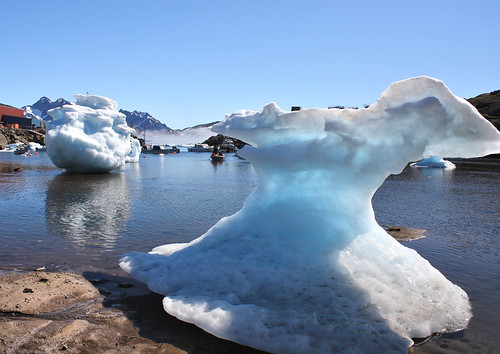Greenland's Glaciers Loom Larger as Source of Sea Level Rise
A new study shows how fast Greenland's glaciers and ice cap are melting
 |
| According to research, the southeastern part of Greenland is melting more rapidly than the northern part. Image: Flickr/Christine Zenino |
Greenland's glaciers and ice caps are melting to such a degree that they are "significant" contributors to global sea level rise and constitute 20 percent of Greenland's overall mass loss, according to a new study.
The research breaks new ground in measuring the melting dynamic of Greenland's local glaciers separately from its larger ice sheet. It is the first such estimate of the country's glaciers and ice caps by themselves and sets the stage for much better predictions of rising sea levels, the researchers said.
"It is not only Greenland's ice sheet that matters," said Tobias Bolch, a glacier expert at the University of Zurich and lead author of the study published in Geophysical Research Letters. "The glaciers are reacting faster to climate change than the ice sheet."
The research team measured two types of Greenland glaciers -- those that are entirely separate from its massive ice sheet and those that have some physical connection but operate independently. As an example, Bolch said there are some glaciers that technically are linked to the ice sheet but exhibit a completely different pattern of water flow, essentially making them separate.
The area of the studied glaciers is about 50 times higher than the ice cover of the European Alps.
The scientists were able to pinpoint what is happening with the glaciers because of an unprecedented Greenland glacier inventory completed last year. They compared that information with additional NASA satellite data showing precise measurements of land elevations down to 50 centimeters.
As a result, they could calculate the mass loss of Greenland fueled by melting. Between 2003 and 2008, Greenland glaciers and ice caps contributed about 50 gigatons of water annually to global sea levels, the study says.
Cause of faster melting remains unknown
That is roughly 10 percent of the water contribution from all the world's glaciers and ice caps. It is also roughly one-fifth of Greenland's total during the same period, the scientists said.
That is significant, Bolch said, because the glaciers constitute a much smaller percentage of Greenland's overall ice cover -- about 5 to 7 percent. The findings confirm that the glacier and ice cap regions are melting much faster than Greenland as a whole, he said.
"We don't know exactly why," he said. One explanation is that the glaciers typically are at lower elevations, where it is warmer on average and more susceptible to melting as a result.
While it is too early to know for sure, it is likely that the glaciers will contribute a similar significant percentage to global sea level rise over the next century, he said. That means there needs to be additional field work documenting their characteristics, such as ice density, he said.
The southeastern part of Greenland also is melting more rapidly than the northern part, according to the research.
That is surprising in the sense that the southeast is Greenland's snowiest spot, a phenomenon that should in theory offset melting from rising temperatures, said Anders Carlson, an associate professor at Oregon State University who did not participate in the study. But clearly the mass loss from melting is outweighing the snowfall, he said.
"One possible explanation is that in this [southeast] region many of the glaciers terminate in the ocean, so there are additional mass losses of icebergs calving off and the ice melting directly in contact with ocean water," he said.
Lending uncertainty to sea level estimates
Ian Joughin, a glaciologist at the University of Washington who did not participate in the study, said the paper "is a nice piece of work," even though it tracked a limited time period. While there are still some uncertainties, it is doubtful there "will be any major surprises when newer [satellite] instruments with better coverage are launched," he said.
NASA is scheduled to launch its Ice, Cloud and Land Elevation Satellite-2 (ICESat-2) in July 2016, which should provide further precise measurements of Greenland ice. The original ICESat satellite used by the researchers stopped gathering data in 2010. In the meantime, the agency said last week it is continuing air flights to monitor Arctic and Antarctic sea ice.
Last year, scientists warned that the Greenland and Antarctica ice sheets are shrinking three times faster than they were in the 1990s, with Greenland experiencing the most dramatic melt (ClimateWire, Nov. 30, 2012).
Many scientists further agree that global sea levels will rise roughly 3 feet by 2100, but there is high uncertainty in the number. The margin of error makes it difficult for regional planners in coastal regions, such as in south Florida, to plan ahead with building codes and land management decisions.
Bolch said he is working on a study -- set for release in a few weeks -- using similar precise methodology of mass loss for non-Greenland glaciers. That, combined with the just-released study, should provide a much better picture of the future, he said.
Greenland glaciers will "be a factor to consider for estimating future sea level rise, particularly since the new inventory suggests that they represent about 12 percent of the global area covered by glaciers," Carlson said.
Reprinted from Climatewire with permission from Environment & Energy Publishing, LLC. www.eenews.net, 202-628-6500


Comentários
Postar um comentário